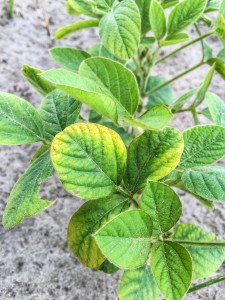Due to favorable prices, Columbia County farmers have planted more soybeans than in the past several years. Some of these soybean crops are showing deficiency symptoms indicative of insufficient potassium. Potassium deficiency is easy to identify in soybeans, and soybeans are responsive to supplemental fertilizer applications.
Potassium is mobile in plants and will move from lower to upper leaves; therefore deficiency symptoms are found on lower, older leaves. The first signs to appear are on the margins of the leaflets. The leaflets turn light green to yellow on the margins and may display burnt yellow edges.
The availability of potassium in sandy soils is generally inadequate for maximum soybean yields. Broadcast fertilizer applications tend to be the most traditional and preferred method of potassium application. According to recent research by Mallarino et al., a 55 bushel soybean crop takes up 180 pounds of potash equivalent per acre, and grain removal is 80 pounds of potash equivalent per acre. Soil testing should be used to determine plant available nutrients in the soil, and fertilizer applications made accordingly.
Scource: Mallarino et al., 2011. http://www.agronext.iastate.edu/soilfertility/info/mallarino-2.pdf
Posted by: Sarah Chambers, Extension Intern

